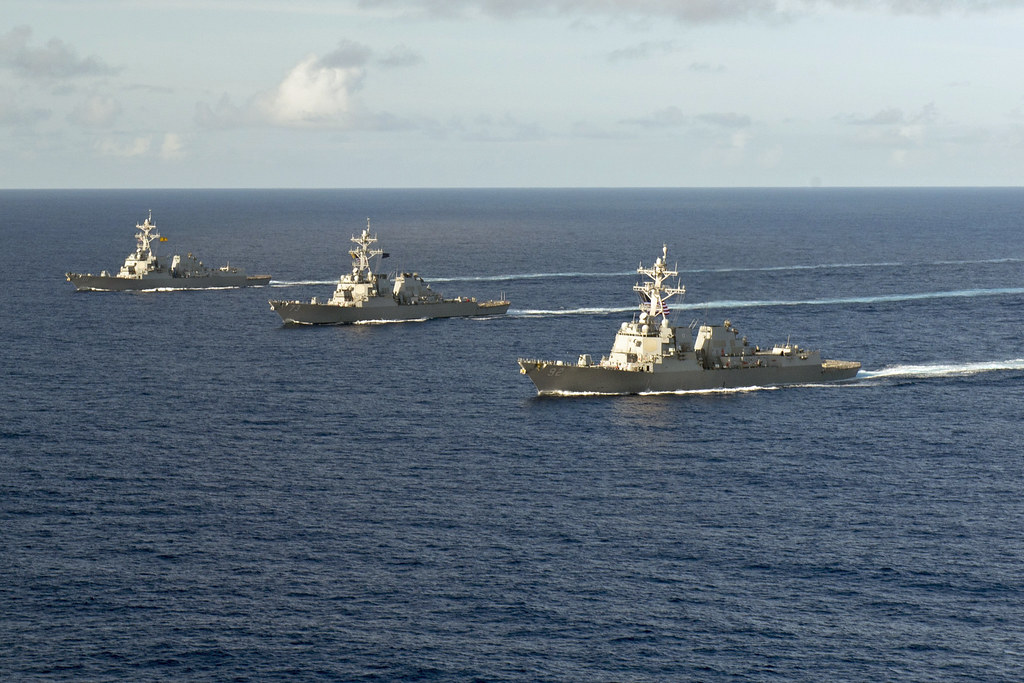PACIFIC OCEAN (April 20, 2016) The guided-missile destroyers USS Spruance (DDG 111), USS Decatur (DDG 73) and USS Momsen (DDG 92) steam in formation. The ships, along with embarked detachments of Helicopter Maritime Strike Squadron (HSM) 49, are deployed as part of a U.S. 3rd Fleet Pacific Surface Action Group (PAC SAG) under Destroyer Squadron (CDS) 31. (U.S. Navy photo by Mass Communication Specialist 2nd Class Will Gaskill) [Image: Flickr User - U.S. Pacific Fleet] >>
By Mass Communication Specialist 3rd Class Gerald Dudley Reynolds, USS Decatur Public Affairs
PHILIPPINE SEA (NNS) -- A member of the Royal Australian Navy deployed with the inaugural U.S. 3rd Fleet Pacific Surface Action Group is helping enhance bilateral relations and support interoperability between the U.S. and Australia through the Personnel Exchange Program (PEP).
Lt. Cmdr. Aaron Scott of the Royal Australian Navy was selected for the two-year exchange program and assigned to Destroyer Squadron (CDS) 31, the staff overseeing the PAC SAG.
The PEP provides one-on-one exchanges between U.S. Navy officers or career-designated petty officers and personnel from other military services or select foreign countries, including Argentina, Italy and Japan.
"After being in the Royal Australian Navy for 13 years and being on deployments to the Middle East and being on over a half dozen ships, being here is definitely a once in a lifetime opportunity, and I am happy that I was selected for it," Scott said.
Under the operational control of Commander, U.S. 3rd Fleet, PAC SAG consists of destroyers USS Momsen (DDG 92), USS Decatur (DDG 73), USS Spruance (DDG 111) and the embarked "Devil Fish" and "Warbirds" detachments of Helicopter Strike Squadron (HSM) 49, demonstrating the 3rd Fleet Forward concept.
Scott began his deployment in April with the CDS 31 staff on board Momsen before transferring to Decatur in July. As the principal warfare officer, one of the main objectives of his position is to study the Aegis combat system.
"The RAN is currently designing destroyers, and we are taking the Aegis combat system and installing it into our ships," Scott said. "I have eight months left in the program, and it has been life changing."
Scott said another benefit of the program was the opportunity to visit several U.S. states prior arriving in Hawaii.
"The hospitality of not just the American people but of the U.S. Navy has made my adaptation and learning easy and fun," Scott said. "I am proud and happy that Australia is working and learning from such a professional country and military."
While the style of naval training for the two countries is similar, Scott said the Aegis system on board provides an advantage.
"We have damage control training and various simulated casualty trainings where we create different scenarios," Scott said. "The one thing that the U.S. has is that Aegis allows for training and collaboration between different ships. The crew aboard has been helping me with these challenges and how to learn the different warfare areas on the ship."
Capt. Charles Johnson, commander, CDS-31, said PEP provides benefits for participating nations.
"This exchange program is an example of us working closely with the Australian military in helping to increase the securing of peace and prosperity in the Indo-Asia-Pacific region," said Johnson. "Having Scott with us emphasizes the importance of countries learning from one another. He provides an important outlook for the PAC SAG and CDS 31, and just as he learns from us, we learn from him."
Scott also expressed various other benefits he acquired from not just the deployment but from the exchange program as a whole.
"From a professional standpoint, this PAC SAG deployment has allowed me to learn how to organize and control a SAG and to pay attention to detail," said Scott, noting that perhaps the biggest benefit of participating in PEP and being stationed to Hawaii was meeting his future wife. "That definitely makes my time over here as a highlight of my career," he added.
Scott will stay busy after the exchange program is finished as he begins training for his next tour as the executive officer of HMAS Anzac (FFGHM 150).
Since departing on deployment in April, the 3rd Fleet PAC SAG executed various naval activities and routine missions in the Western Pacific, including Oceania Maritime Security Initiative (OMSI) as well as joint exercises with U.S. Air Force and the U.S. Marine Corps and bilateral exercises several countries, including Republic of Korea, Australia and Japan, helping to strengthen international maritime relations.
The U.S. Navy maintains a presence in the Indo-Asia-Pacific region to help preserve peace and security and to further partnerships with friends and allies. The 3rd Fleet PAC SAG initiative leverages the technological and tactical assets of the three modern destroyers, allowing for a quick response to virtually any situation in the region.
U.S. 3rd Fleet leads naval forces in the Pacific and provides the realistic, relevant training necessary for an effective global Navy. Third Fleet works constantly with U.S. 7th Fleet. The forces of both Fleets complement one another across the spectrum of military operations in the Pacific.

